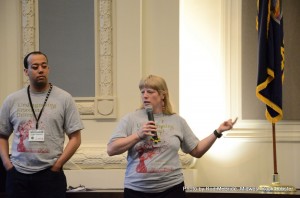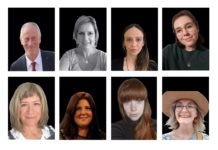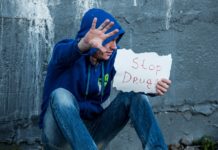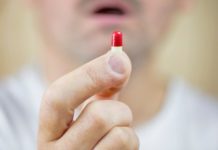There are two main problems with the term “medical model.” First, it automatically frames the debate in the terms of the oppressor, and secondly, it’s confusing. Many people in our community say “medical model” when we mean, “The idea that something wrong in my brain caused my emotional suffering.” So why not just use a term that says this? When we say “Disease Model” we can clarify exactly what we are against. With just one word changed we can say we do not believe that a mental “disease” came from nowhere to put us out of action.

What really causes emotional distress? Bad situations in our lives, trauma, nutritional imbalances, head injuries, poor job fits, family dynamics, not enough exercise, or some other kind of overwhelming of our internal self-support strategies. (And you can get the T-shirt here to wear this statement proudly.)
I’ve outlined on my personal blog the scientific and biochemical cascade of events that shows that emotional distress causes psychosis, not the other way around. Life situations cause chemical changes all the time or else you’re dead. Everyone’s brain reacts to what is happening in their life with chemical shifts and adjustments. Scientists look at these chemical shifts and adjustments and come up with all kinds of theories. The question is, “Do folks who end up with mental health labels have different patterns of chemical responses to events?” OR “Is the disease model accurate?”
Most of the science that we look at on this blog says, “NO, there is no difference in brain chemisty between people who get labeled or those who don’t.” Most of the differences found are artifacts of the extreme emotional state. For instance, I’ve seen those big bold brain scan pics that show huge shifts in people labeled with “schizophrenia.” They say folks who are currently symptomatic have different brain activity than people who never were symptomatic. But this just shows that psychosis is a powerful emotional and mental state, and lots of stuff is happening in the brain.

The real question would be, “Do people labeled with schizophrenia who are NOT symptomatic at the time show any diifferences in brain activity than people without the label?” And the answer is no. Ron Unger had to explain this to me with an email exchange. I heard it as well from a bunch of brain scan research folks at a Translational Medicine conference that I’ll report on soon for this blog. The importance of this is that both ways to frame this question are medical. Both questions ask about what the science says about the brain, but only one talks about a “disease.”
If we are going to criticize the “medical model” as shorthand for saying, “I don’t think emotional distress is caused by a disease,” then we just need to use our own terminology that says this. I always replace “Medical Model” with “Disease Model,” and in every situation that I’ve done this, the meaning is much more clear. It ‘s just a one word shift, but very powerful.
My friend Ken Braiterman wrote a blog about how using an opponent’s language to frame an argument will almost always lose the argument. He pointed out that one of the reasons that Democrats lose many public policy debates is that they use Republican terms to form the arguments. For instance, he says that the battle was lost when “Health Insurance Reform” became “Health Care Reform” because people like their health care. He also says that criticizing “tax cuts for rich” fails. People like tax cuts in general, and also hope to be rich someday. They should have called for “balanced contributions from all,” or “fair tax policy” or something like that.
In a similar way, I suggest we reframe mental health debates to have a disease model vs. a distress model of “mental illness”. This is a framing that puts blame for spreading the disease myth squarely on the people who benefitted financially for it.

Each way of looking at the debate or using language determines how the debate will proceed. When we say, “The medical model is wrong, but I believe in recovery,” we have framed the debate in their terms. Because recovery IS evidence based. It IS science based. It IS a medical model, in fact the only accurate medical model. So whenever we criticize the “medical model” we run ourselves into a factual circle which a previous blogger on this site got stuck in when he tried to explain why it’s hard to make the medical model go away. Because science isn’t going away.
However, it will be a lot easier to make the “Disease Model” of emotional distress go away. David Oaks wrote an essay called, “Let’s Stop Saying ‘Mental Illness.'” where he explained why and how it was important to make inaccurate words go away. This essay helped me realize how much I was using the terms of the oppressor. We don’t have to do this. We can build our own language, we can choose how we want to label our emotional experiences. We can choose to share our stories and our alternatives at the same time. No one will be able to hear our criticisms when they think what they have to offer is the only thing available for our brothers and sisters in crisis. Using accurate language neatly describes both the problem and the solution. It shines a beacon of hope.
“Distress model” says that strong emotional experiences are a normal response to abnormal events. All people can equally experience these states given enough emotional distress and not enough supports or resilience. This language allows us to maintain control of the science that is increasingly on our side. It helps us be “for something,” not just against something. But most importantly, looking at things from a distress perspective rather than a disease perspective shows immediate solutions. It shows a much more hopeful message about complete recovery. It shows both how and why we have been able to walk through the fire and come out stronger people. And this is a message we want to share.















“Distress Medel” works well, IMO.
Good post, Corinna.
Duane
Report comment
typo – model
Report comment
Corinna,
To clarify – I think the “distress model” is a good term for people whose root cause is emotional distress… however, I think that for many people there are underlying physical conditions behind their so-called “mental” illness… and these folks can benefit greatly by having these conditions addressed –
http://discoverandrecover.wordpress.com/category/root-causes-of-mental-illness/
Ironically, there are sometimes actual real diseases that can cause these problems, such as lyme disease and others (see link above)… but they need treatment by REAL doctors, not psychiatrists!, who simply mask symptoms by using chemucal agents that injure, impede recovery and cause disability with long-term use.
So, I suppose finding the exact term may be more difficult than at-first meets the eye.
Duane
Report comment
Maybe we should refer to the old model as the “Psychiatric Model.”
And the new one as the “Recovery Model” and/or “Recovery and Wellness Model.”
This would leave room for real medicine, such as treatment for thyroid conditions, etc; along with showing appreciation for nutrition, exercise, acupuncture, etc.
Duane
Report comment
And it would take into account those folks who truly have brain injury, such as those who have suffered Traumatic Brain Injury (organic), not the least of whom are military service members who benefit from Hyperbaric Oxygen Therapy (not psychiatric drugs)…
There are lots of ways the brain heals, and real healing can take place (neuroplasticity is very real), as long as a person avoids pscychiatry (avoids it like the plague!)
Duane
Report comment
I agree with the idea that the language we use is very important. “Disease model” rather than “medical model” sounds like a good idea too. It does express what we mean, and people have a tendency to perceive anything “medical” as a good thing, which makes it harder for us to convince them that psychiatry”s lies shouldn’t be believed.
Well thought out post.
Report comment
For all of the excellent reasons you have stated and in keeping with a commitment to truth telling, “Disease Model” is the biomedical psychiatry paradigm, and “Medical Model” captures both the scientific method employed to create the premise for “Recovery”, and the process for developing effective interventions for people in “Distress”.
“Medical mode”l utilizes problem oriented recording that prompts rational, critical thinking. The foundation is the SOAP note; documentation of an encounter.
S= Subjective. The “I” statements a person makes as well as their expressed perceptions of their problem and the way in which it impacts him/her, personally as an individual.
O= Objective. Observations and relevant data, which includes measurements, lab tests. example: Thyroid function abnormalities present at the onset of the ‘problem’—
A= Assessment. What seems to be going on…
P= Plan. Action, intervention…
in the late 70’s IER was added…
I= intervention. documented
E= Evaluation. of intervention
This is the ‘model’ for working with someone who is struggling with a problem that highlights the “Subjective” and creates a partnership in resolving crisis. It evokes critical thinking that reflects acknowledgement of the person suffering as the primary source of information. This is how i approach Recovery planning with mislabeled, psychiatric patients.
the current *Disease Model* dismisses the person as a credible and valuable resource. The *Disease Model* is a reflection of bias towards an *expert* observer who determines what disease to diagnose based upon the *effect* the person’s problem has on him/her and significant others— including society.
IF only we tell the truth. Say what we think and not what we don’t really think or believe— we can create the crucial common language that will increase the power of our movement exponentially — or so i believe.
Thanks for another great post 🙂
R= Revision. back to the drawing board… or maybe NOT. success happens, too.
Report comment
I am totally with you on the fact that language is important. I appreciate the language of the distress model, it has a way to convey the fact that recovery is possible. That language helps counter the common practice of diagnosing a permanent disease which is both unscientific and dangerous, as well as the common practice of assuming genetic causality.
That said, for even more accuracy, it might be better to oppose the “distress model” to the “permanent disease model” rather than to the “disease model” (by itself “disease” can be temporary as in flu, cold, chicken pox).
Another thing: it would be extremely counter-productive to alienate similarly-minded people just because of language issues. Promoting the use of some vocabulary like “madness vs mental illness” or “distress vs disease” makes sense because of the historical unsound use of those terms, but most truths can be expressed in different languages, and vocabulary should never be a show-stopper when evaluating an idea.
Report comment
By the same token, Stan, when there terms, words, language is misused, the result is confusion that interferes with establishing the unity of purpose that leads to victory.
Agreement on the meaning of language is a value, or principle that I would think everyone would support. Values and principles before personal bias and personal feelings is professional behavior…. or what it used to be…
Remember when “First, do no harm” was a standard to be upheld by every licensed physician? What happens when attitudes of entitlement take priority over standards of conduct? In other words, without principles, standards that all are accountable for, — every from of human rights violations & social injustice abounds. All in the name of someone’s own arbitrary view of the definition of terms, and the use of language… and the tried and true consensus model, of course.
Report comment
Wow! sorry for the confusion around my opening sentence. I meant to convey that when there is confusion over the meaning of terms and the meaning of language used, developing unity of purpose is all but impossible.
Report comment
I agree that it is hard to communicate, debate and get things done without having a consensus on the meaning of words.
But reaching that dictionary/glossary consensus is by itself extremely hard. Defining the meaning of words is by definition a mostly circular reasoning exercise. Not counting that everybody gets defensive about their own pre-existing definitions (and since most people associate emotional value to words, language is not neutral, which I think was one of the point made by Corinna here).
If you were to have every participant of MIA create from memory a dictionary of the terms commonly used, you would get a number of partly irreconcilable dictionaries (both in meanings, and also with different emotional value attached to words). To understand each other, we have to always make an effort from context to be aware of the possible personal variations in our language.
For instance, the word “disease” has a completely different definition for different MIA participants.
Report comment
If you chip away everything that doesn’t describe or define psychiatry, then you can appreciate what psychiatry IS, by sifting through the residue. Medical Model will be located in the heap of stuff that got chipped off because it neither describes or defines psychiatry.
Report comment
While I agree that the “distress model” (or the trauma model)is much more accurate and in tune with people’s real experiences, I don’t understand the distinction you’re trying to make between the medical model and the disease model (not thta I like the term “model” at all). To my knowledge, the “oppressors” don’t refer to their position as the “medical model” – they just call it the truth (without aknowledging that their “truth” is totally unproven). I really don’t see why it’s a problem to refer to the medical model. The points you made about distress are much more important than quibbling over “medical” and “disease.”
Report comment
Well, many people link “medicine” and science in their minds. Yet we know there was no chemical imbalance so using chemical cures doesn’t really work. So we still need science to refute the liars, and anything that weakens our connection to science weakens our overall argument.
You are right, “medical model” is only a term heard from advocates, so we advocates should be able to change our language if we want.
It’s very difficult to make those points about distress if someone has already tuned out your conversation because they think you are in denial of science.
Report comment
Sadly, this is exactly what Mr Whitaker and many others do; they describe people as ‘mentally ill’, which to my mind constitutes an obeisance to the oppressors and their authority, who rely, for the perpetuity of their tyranny, on such an unthinking use of their odious, illiberal, irrational concepts.
To me, using the term ‘mental illness’, whilst professing at least outwardly to desire reformation for the way in which the recipients of these diagnoses are treated, is like talking about the rights of African Americans whilst calling them ‘nigg@h’, or ‘sambo’, or ‘three-fifths’ human beings. It is traditionally a verbal instrument in the bullying of others. It must be repudiated so that future generations are free from the influence of this verbal canker.
Why do we consider those aforementioned terms offensive, regardless of who uses them? Because words cannot be disjoined from the meaning they acquire through common usage in the society in which their are uttered, by professionals and laypeople alike.
‘Mental illness’, like the aforementioned scurrilities, is a dirty word, a term of derogation, whilst also being a contradiction in terms, yet practically all of the so-called reformers use it (people whose intentions Szasz rightly questions in a number of books).
Maybe the dehumanising, intolerant, arrogant view of psychosocial difference of so many nominal authorities on this issue is the result of a ‘mental illness’. There would be just as little evidence for one as there would the other.
‘Mental illness’ is a stigmatising, dehumanising term, that fosters an us/them dichotomy, leading to the despicable state of affairs today whereby moral degenerates (like psychiatrists), liars and bigots are encouraged to believe that their modes of being, experiencing and expressing are ‘healthy’, as well as promoting the preponderant habit amongst the herd and by professionals in many situational contexts, without verification independent of the commonly believed to be infallible judgement itself, of using this status as an instrument in the destruction of the most powerless.
What better reason could there be for flushing this piece of verbal refuse down the toilet, where it belongs, so it can take its rightful place in the sewer with the other turds, this language constructed in the bowels of the intolerant and despotic?
The very fact that these psychiatric concepts are being used by people like that Goebbelsian weasel E Fuller Torquemada, Sally Satel and Gina Pera should be ample reason for a rethinking of the language, as well of course that they have also been shown to be purely in the eye of the beholder.
Report comment
The Medical Model’s Four Reasons for Brain Dysfunction (Biology and Human Behavior: The Neurological Origins of Individuality, Professor Robert Sapolsky, Stanford University, The Great Courses, The Teaching Company © 1996)
1. Anatomical abnormalities or damage
2. Lack of oxygen or glucose
3. Electrolyte imbalance
4. Neurotransmitter deregulation: the imbalance of brain chemistry.
Trauma is a significant reason for brain dysfunction. Due to trauma the hypo-campus can shrink in size causing problems in communication between various areas of the brain. As such it would fall into category 1. Magnesium deficiencies (magnesium is a major component of serotonin) and may be responsible for much of the so called ‘mental illnesses’. It is not the medical model which is wrong, but NAMI, Torrey, and the drug companies which have been promoting ignorance by claiming #4 (imbalance of brain chemistry) is the entire medical model which is the problem. They need to be called on it – our future is as stake.
Report comment
R.D. Laing coined the term ‘medical model’ to distinguish his approach to psychiatry from that of biological reductionist psychiatry. A more recent version of the term is bio-medical model. Biological reductionist psychiatry then is medical model psychiatry.
In the criminal justice system one is presumed innocent until proven guilty by a court of law. In the mental health system one is presumed “sick” until pronounced “well” by a mental health expert. If the problem was not medical to begin with, the “patient” was not literally “sick”, or, another way to put it, the “patient” was literally not “sick”.
When you’d perceive distress in terms of wellness you are still using a medical model. Distress is not sickness, and the psychiatrist is not a knight in shining armor. If a person is in an abusive relationship, of course, this abuse is going to cause distress. What distress is not is illness, and wellness is not what you get in response to it. The answer to an abusive relationship are relationships that don’t involve abuse. Equally, if a person is in a bad situation, it is going to be stressful, while an improved situation is going to mean, in all probability, less stress.
I wouldn’t, as you seem to be trying to do, juxtapose one medicine with another, and say that it is merely a matter of our medicine being scientific while their medicine is not scientific. Psychiatry is not medicine in point of fact, psychiatry is only pretend medicine.
Report comment
I totally agree with you that a distress model rather than a disease model is much more appropriate in helping a person with emotional struggles. A distress model was a fundamental aspect of what was called the biopsychosocial approach in psychiatry where all aspects of a person;s life that could contribute to distress were considered important. This model has been largely dropped in favour of the ridiculous and dangerous biological model.
In medicine, the medical model has always had value. One main problem in psychiatry is that the medical model is no longer being followed. The medical model is based on the importance of understanding the underlying causes of distress. In this model one elicits problems and symptoms to then investigate the underlying etiology. One then attempts to treat the causes of distress to help the individual. If one uses this model in psychiatry and psychology, then one always ends up using a distress model and attending to the underlying causes of the distress. The DSM is not, nor was it ever intended to be based on etiology. In fact, it was created to avoid having to address etiology at all, as previous classifications had been based on implied etiologies that could not be proven. However, one of the main reasons for the rise of biological psychiatry is that doctors end up assuming DSM diagnoses do imply etiology. They end up trying to use the medical model with a classification system where it doesn’t apply. Big pharma also push their drugs in this way.
We need to continue to promote the importance of looking for the underlying causes of distress, whatever those causes may be.
Report comment